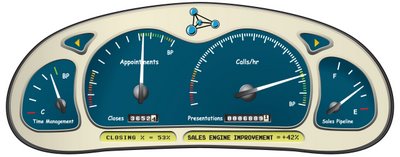What are the Metrics that Matter?
Most Sales Departments stink when it comes to tracking their numbers. The question upper management ALWAYS asks is why? My two cents; we don’t know the most important numbers to track and we don’t realize how important they are to our entire selling effort. Well, those excuses end today!
Indicators
The first area that we need to clear up is the difference between trailing and leading indicators. Trailing indicators refer to metrics that happen as a RESULT or in the past. Number of sales closed or total dollar amount closed are examples of the trailing variety. Leading indicators are what foretell objectives and what results will be in the future. The activities that a sales person performs on a daily basis, such as phone calls or appointments, are examples of leading indicators.
We always need to know how many and how much business has been closed (trailing) but we can’t control the actual closing of the sale. That is why we can never lose sight of the activities (leading) it takes to fill the pipeline and, more importantly, directly affect the closing of the sale. This is crucial to short and long term forecasting accuracy and critically more important to overall SALES SUCCESS.
Leading Metric Indicators
I first focus on the BIG 4 of Leading Metric Indicators (LMI’s): Calls, Discovery Appointments, Presentations and Closes. These are pillars of a sale that will tell you the overall picture of what is working, why it is working and what needs to be fixed.
The next LMI’s that I track are more descriptive of the sales reps everyday work.
- How many leads (non-qualified contacts) are they working on?
- How many opportunities (qualified contacts in the buying cycle) are they working on?
- What type of accounts are the reps calling on?
- What is the job function of their main contact?
If the BIG 4 gives you the overall picture, when you drill down to this level you uncover more of the texture in the everyday activities of your sales team. Not just the raw numbers but WHY you are getting the raw numbers. When we understand both sets of LMI’s and their conversion rates it helps us to more accurately predict closing rates in the near and long term.
Trailing Metrics Indicators
I always track total number of closed sales and total sales dollars. They are important and necessary to measure where we have finished historically, yet it always amazes me what sales management forgets to measure in the Trailing Metric Indicator (TMI) category.
A.U.S.P. or average unit selling price is the total sales dollars divided by the total number of sales. For example if total sales dollars are $100,000 and total number sales are 10 your A.U.S.P. equals $10,000. Knowing this number tells you how many sales it will take to hit your objective. This TMI is key to planning your goals and objectives throughout the year.
The final TMI I track is Average Velocity of Sale or the A.V.O.S. This is the average time from when a lead becomes an opportunity to when it converts to a sale. Having the handle on this metric allows you to realistically plan WHEN your business is going to hit.
Wrap Up
12 chapters of data making up one book; lose one of the chapters and you wonder how and why things are happening. Lose two chapters and the story starts to sound nonsensical. Lose three and you wonder why you started reading the book at all. 12 categories of data when monitored and measured can radically affect your sales team’s short and long term success and viability.
Sure it takes time and getting sales to record their info is difficult. Keeping up with the numbers is a job in of itself. I have heard all of the excuses before. I leave you with a question. If you could produce a set of numbers telling you how to improve, what to improve and when to improve your sales results wouldn’t you want to know them and wouldn’t you do everything in your power to track them? Yea, I don’t know either…
Be Hassle Free
I was clicking through the cable stations the other night and settled on a rerun of “The West Wing” for some background noise. Not particularly paying attention until toward the end of the episode I heard a line from the character of ‘Danny Cocannon’ talking to ‘Charlie Young’.
Charlie was lamenting dating the President’s daughter because of various issues, I couldn’t tell you what (again background noise). Then I heard Danny say “If it was me I would want to be the one hassle free person in her life” BOOM. Isn’t that EXACTLY what we should be to our customers?
(You Can View the clip here Be The 1 hassle free Person)
We should be the one hassle free thing in our customers’ life. As salespeople we spend most of our time strategizing on how to find the customer, how to question the customer and how to negotiate with the customer so we can win the sale. What if INSTEAD we spent a little more time thinking about things from their perspective?
Our customers, by definition, have to be decision makers. As a general rule, they must have some level of authority and responsibility. So what daily tasks, problems and ordeals accompany those two duties?
- 100’s of phone calls
- 100’s of email
- Management reporting and meetings
- Employee problems
- Internal power struggles
- Logistical challenges
- Other vendors issues
- Personal issues
I know what you might be thinking. “My boss doesn’t care about these things” or maybe “I have quota to make I can’t worry about their problems.” Well I am here to tell you if you don’t worry about their problems you will NEVER solve your own!
There are 1000’s of things that can crop up at any time for our customer and we are only ONE of them. The patience and professionalism we exhibit in working our way into customer’s daily schedule will determine how they perceive us and ultimately the level of success we experience.
Below are 5 ways we can Be Hassle Free in the face of these daily dilemmas:
- Only call if you have a REASON or NEED to call, not because “I just wanted to…”
- Email if you have something relevant, helpful, informational etc. not the joke of the day or “I was just checking in.”
- Respect their time! Recognize you are only one small part of their day and make the time you share with them COUNT. Be prepared for every meeting, phone call and presentation. Never waste their time.
- If they choose to share any problem situation with you tread carefully. YouARENOT the business equivalent of Dr. Ruth, but you can find information online that might address their concerns.
- Be humble and empathize but DO NOT commiserate. Realize there will be problems you can’t help with but let them know you understand their situation and will be as supportive as possible.
It comes down to this; we need to find a way to become a POSITIVE in the customer’s day. Whenever they see your number on caller ID they should want to take the call because they know you will share something of value with them. You might be calling with an idea or with information about their industry or maybe even a solution to their problem. Whatever it may be, they have to WANT to talk to you.
Be the one hassle free thing in their daily existence; an oasis from the desert of problems they face. Provide valuable resources and make their life easier. Find something they need that has NOTHING to do with your business and HELP THEM. You have to go OUTSIDE your job description and do things your competitors wouldn’t even think of if you truly want to help people.
It is a lot of work I know but I promise, if you do, the business relationship will grow and your sales will skyrocket. It is a choice you have to make everyday so choose wisely, the job you save just might be your own.
Archives
- May 2018
- November 2016
- June 2016
- April 2016
- March 2016
- February 2016
- January 2016
- February 2012
- January 2012
- December 2011
- October 2011
- August 2011
- July 2011
- June 2011
- May 2011
- April 2011
- March 2011
- February 2011
- July 2009
- June 2009
- May 2009
- August 2008
- June 2008
- May 2008
- April 2008
Categories
- A-Players
- Best Practice
- Change
- Cold Call
- Communication Skills
- Continual Development
- Critique Session
- Customer
- D.I.G.
- Drive
- Firing
- Guts
- Handling criticism
- Hiring and Assessment
- Hiring Dashboard
- Human Resources
- Intelligence
- interview questions
- Interviewing
- interviewing sales superstars
- Lead Generation
- Leads
- Motivation
- Naturally Curious
- New Contact Touches
- Position Contracts
- Proposals That Sell
- Prospects
- Reference Checks
- S.I.T. Blitz
- S.I.T. Nurture Prospecting System
- S.I.T. Touch
- Sales 3.0
- Sales Blitz
- Sales Management
- Sales Superstars
- Simulations
- Skill Sets
- Staffing
- Suspect/Prospect/ Customer Dynamic
- Suspects
- Talent and Traits
- Termination
- Uncategorized







